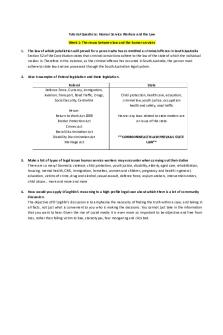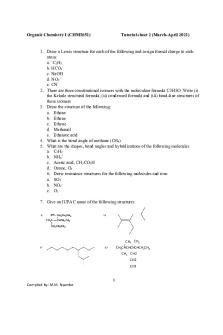Ass5 - tutorial PDF

| Title | Ass5 - tutorial |
|---|---|
| Course | Dynamics |
| Institution | University of Windsor |
| Pages | 26 |
| File Size | 1.8 MB |
| File Type | |
| Total Downloads | 14 |
| Total Views | 135 |
Summary
tutorial ...
Description
UNIVERSITY OF WINDSOR DEPARTMENT OF MECHANICAL, AUTOMOTIVE AND MATERIALS ENGINEERING COURSE 92-323, MACHINE DYNAMICS ASSIGNMENT #5
Due:
Nov/10th/2008 th Nov/17 /2008
1. Mathcad assignment as follows:
Mathcad Tutorial Part 3: Symbolic Math—Algebraic Equations Work your way through the tutorial, answering the questions using Mathcad; when finished, print the worksheet and hand in. In the following, keystrokes are enclosed in square brackets, so [A+B] means the keystrokes “A+B“, and [Ctrl=] means keystroke “=” while holding down the control key.
3.1) Introduction to Symbolic Math Consider the equation
x 2 − 7 x + 12 = 0 We can solve this equation, that is find the roots, by using the methods of algebra. So we could write x 2 − 7 x + 12 = ( x − 3)( x − 4) = 0
and from this obtain the solution x=3 and x=4. This is an example of a symbolic calculation: to obtain the solution we are manipulating (calculating with) symbols. In contrast to symbolic calculations, we could find the roots using the Newton-Raphson method. This would be an example of a numerical calculation. What you should understand about symbolic math is that it is the manipulation of symbols, the same thing you would do to solve an algebra problem with pen and paper. What a symbolic calculation is not is a number crunching algorithm. Mathcad has the capability to perform symbolic calculations; so it is possible to use Mathcad as an aid in solving algebraic equations. There are two way to perform symbolic calculations:
(1) (2)
the symbolic equal sign with or without a keyword, or commands from the Symbolics Menu.
The symbolic equal sign is obtained using the keystroke [Ctrl.], or it can be selected from the Symbolic Keyword Toolbar; it will appear on screen as an arrow (→). Keywords are selected from the Symbolic Keyword Toolbar, and commands are selected from the Symbolics Menu at the top menu bar. The operations that can be selected from the Symbolics Menu and the Symbolic Keyword Toolbar are the same, the only difference is that the symbolic equal sign makes the calculations live; on the other hand, commands from the Symbolics Menu are not live. If an operation is live, then the calculation will use previously defined data and changes are automatically updated. But if an operation is not live, then no previously defined data is used and changes are not updated. Operations that are not live are used for calculations that do not have to be tied to the rest of the worksheet. Used alone, the symbolic equal sign mean to simplify. So applied to an expression, it will try to reduce the symbols, if possible. For example, x := 5 y + 5x → y + 25
Question 1.1 Assign x=7 and z=10, then using the symbolic equal sign alone, simplify the following: (a) 5x + 3 y (b) 10 x + 4 y 5 − 17 z
3.2) Solving Equations Using Symbolic Math Symbolic equations use the Boolean equal sign which can be obtained using keystroke [Ctrl=] or from the Boolean Toolbar; it appears on screen as a boldface equal (=). It means that the combination of symbols on the left equals the combinations of symbols on the right. This is the usual algebraic definition of the equal sign. For example, we can enter the symbolic equation [x^2 - 7*x + 12 = 0] where we have used the Boolean equal sign. But note that if the “= 0” is omitted, Mathcad assumes it by default. To solve this equation using symbolic math we can use the symbolic equal sign with the keyword solve from the Toolbar. So,
x := x 2
x − 7x + 12
0 solve ,
→
Entered at the placeholder is the variable to be solved for, in this case “x”; so 2
x − 7x + 12
0 solve , x →
⎛ 3⎞ ⎝ 4⎠
Notice that since this operation is live, previous assignments for x are used in the calculation. To avoid this problem, we first defined x recursively (x:=x). This suppresses previous assignments for the symbolic calculation, but x still retains its assigned value. Not defining x recursively first is a common error. The second way to solve this equation is by highlighting the variable to solve for, in this case “x”, and selecting SymbolicsÆVariableÆSolve from the Symbolics Menu. Question 1.2 Solve the above equation using (a) the symbolic equal sign and the keyword solve, (b) the command solve from the Symbolics Menu, (c) Repeat both (a) and (b), then change the exponent from 2 to 3 (notice the difference between the live and not live operations).
3.3) More Symbolic Operations Question 1.3 Expand the following equations using the symbolic equal sign and the keyword expand: (a) ( x − 1)( x + 1) (b) ( y + 3)( y − 2) ( x − 3) 7 (c) (d) Repeat (a) using the Symbolics Menu. Note: you must highlight the entire expression for the command to be applied to the entire expression and not just part of the expression. Question 1.4 Factor the following equations using the symbolic equal sign and the keyword factor:
Use the symbolic keyword factor on the following: x 2 − 7 x + 12 = 0 (a) (b) 6x 2 + 4 x = 0
(c) (d) (e)
x 4 − 10x 3 − 112x 2 − 134x + 255 251357832 Repeat (a) using the Symbolics Menu.
Question 1.5 Simplify the following equations using the symbolic equal sign and the keyword simplify: (a) ( x − 9 )(x − 2 2 ) (b) Repeat (a) using the Symbolics Menu. Question 1.6 Obtain the partial-fraction expansion of the following equations using the symbolic equal sign and the keyword parfrac: x3 (a) x 3 − 3x + 2 2x − 7 (b) 2 x − 3x + 2 x (c) ( x − 1)( x − b) (d) Repeat (a) using the Symbolics Menus.
3.4) Taylor Series We can use symbolic calculations to obtain the Taylor series expansion of a function. For example, for the exponential function we enter the function and then select the keyword series from the Toolbar x
e series , ,
→
Now in the two placeholder, enter the variable to be expanded for and the order of the error term x
e series , x, 5 → 1 + 1⋅x +
1 4 1 2 1 3 ⋅x ⋅x + ⋅ x + 2 24 6
We can also use the Symbolics Menu by selecting SymbolicsÆVariableÆExpand to series… In this case you will be prompted for the order of the error term. Question 1.7 Obtain the Taylor series for the following functions using the symbolic equal sign and the keyword series to a 5th order error term: (a) sin(θ ) 1 (b) 1− x
(c) (d)
The first expression on p. 36 of the course textbook, do it for both +B and –B. Repeat (a) using the Symbolics Menu.
2. Question 7.1 on page 275 from Mechanisms and Dynamics of Machinery, 4th Edition by Mabie and Reinholtz. 3. Question 7.2 on page 275 from Mechanisms and Dynamics of Machinery, 4th Edition by Mabie and Reinholtz. 4. Question 7.5 on page 275 from Mechanisms and Dynamics of Machinery, 4th Edition by Mabie and Reinholtz. 5. Question 7.6 on page 275 from Mechanisms and Dynamics of Machinery, 4th Edition by Mabie and Reinholtz. 6. Question 7.8 on page 277 from Mechanisms and Dynamics of Machinery, 4th Edition by Mabie and Reinholtz. 7. Question 7.9 on page 278 from Mechanisms and Dynamics of Machinery, 4th Edition by Mabie and Reinholtz....
Similar Free PDFs

Ass5 - tutorial
- 26 Pages

Assignment 5 - Ass5
- 2 Pages

Ass5 - Assignmetn 5
- 1 Pages

Tutorial
- 17 Pages

Tutorial-4 - Tutorial Problems
- 3 Pages

BFW2401-Tutorial 8 - Tutorial
- 2 Pages

Tutorial
- 2 Pages

203-tutorial-9 - Tutorial 9
- 4 Pages

Radiation tutorial
- 3 Pages

Tutorial Questions
- 15 Pages

VisiRule Tutorial
- 42 Pages

Tutorial 1
- 4 Pages
Popular Institutions
- Tinajero National High School - Annex
- Politeknik Caltex Riau
- Yokohama City University
- SGT University
- University of Al-Qadisiyah
- Divine Word College of Vigan
- Techniek College Rotterdam
- Universidade de Santiago
- Universiti Teknologi MARA Cawangan Johor Kampus Pasir Gudang
- Poltekkes Kemenkes Yogyakarta
- Baguio City National High School
- Colegio san marcos
- preparatoria uno
- Centro de Bachillerato Tecnológico Industrial y de Servicios No. 107
- Dalian Maritime University
- Quang Trung Secondary School
- Colegio Tecnológico en Informática
- Corporación Regional de Educación Superior
- Grupo CEDVA
- Dar Al Uloom University
- Centro de Estudios Preuniversitarios de la Universidad Nacional de Ingeniería
- 上智大学
- Aakash International School, Nuna Majara
- San Felipe Neri Catholic School
- Kang Chiao International School - New Taipei City
- Misamis Occidental National High School
- Institución Educativa Escuela Normal Juan Ladrilleros
- Kolehiyo ng Pantukan
- Batanes State College
- Instituto Continental
- Sekolah Menengah Kejuruan Kesehatan Kaltara (Tarakan)
- Colegio de La Inmaculada Concepcion - Cebu



